9.5 Thyroid Gland
Created by CK-12 Foundation/Adapted by Christine Miller
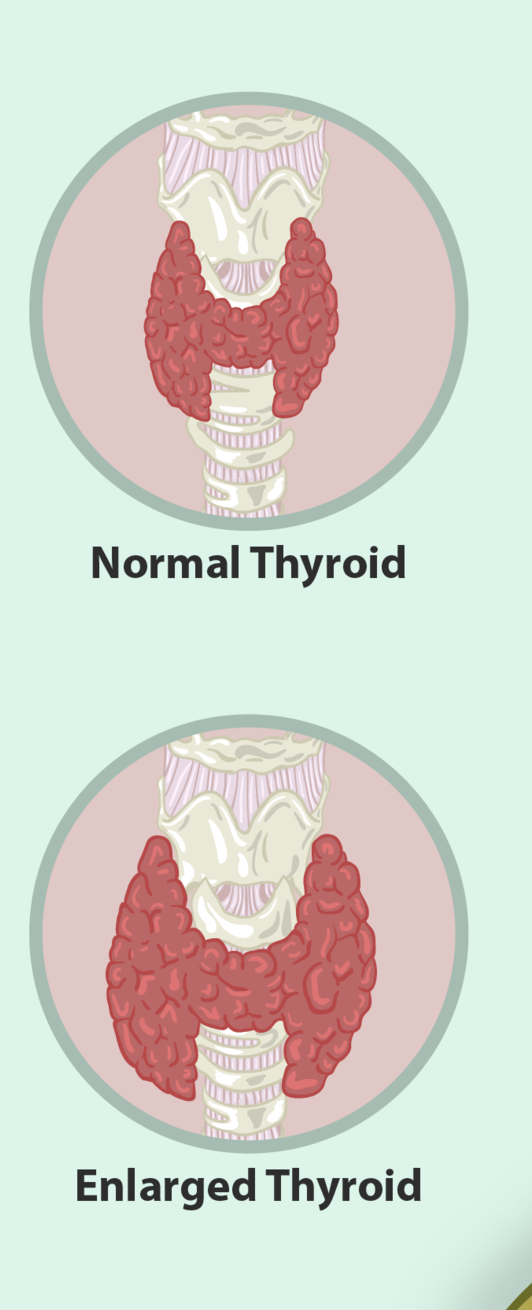
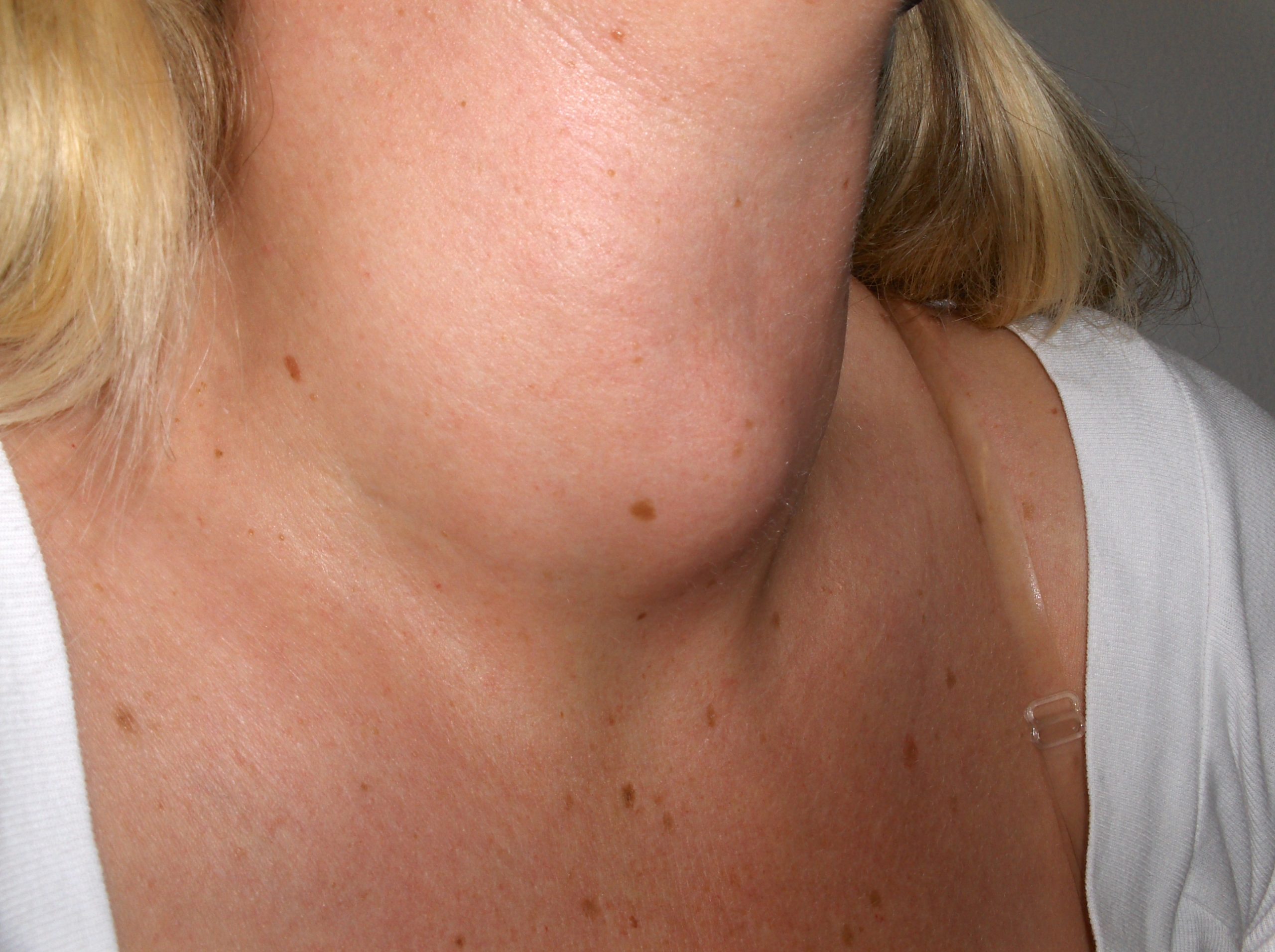
Too Much of a Good Thing
The woman in this photo has a goiter, an abnormal enlargement of the thyroid gland, located in the neck. A goiter may form as a result of a number of different thyroid disorders. You’ll learn why in this section.
Thyroid Structure
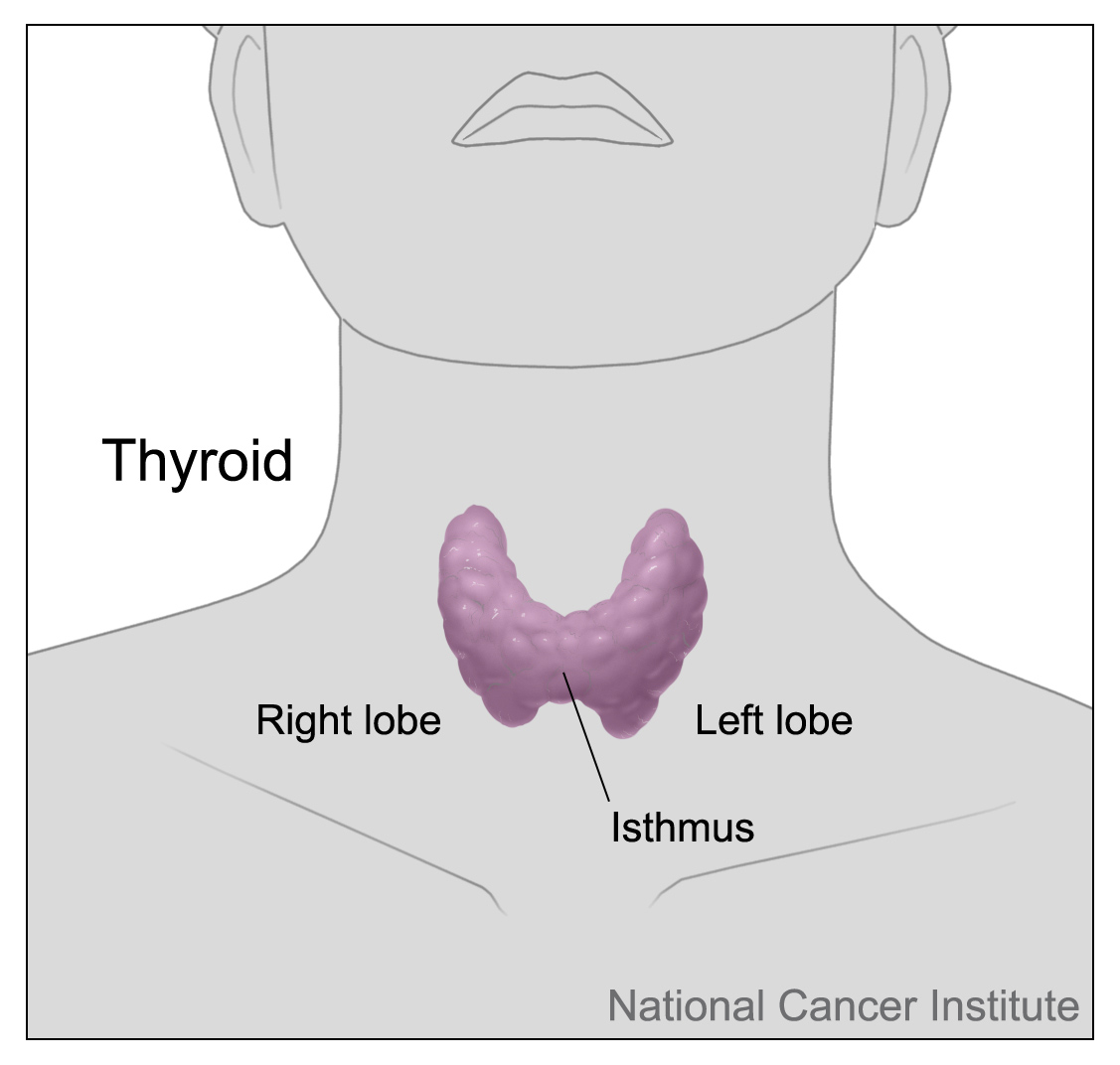
The thyroid gland is one of the largest endocrine glands in the body. It is located in the front of the neck below the Adam’s apple (see Figure 9.5.2). The gland is butterfly shaped and composed of two lobes. The lobes are connected by a narrow band of thyroid tissue called an isthmus.
Internally, the thyroid gland is composed mainly of follicles. A follicle is a small cluster of cells surrounding a central cavity, which stores hormones and other molecules made by the follicular cells. Thyroid follicular cells are unique in being highly specialized to absorb and use iodine. They absorb iodine as iodide ions (I-) from the blood and use the iodide to produce thyroid hormones. The cells also use some of the iodide they absorb to form a protein called thyroglobulin, which serves to store iodide for later hormone synthesis. The outer layer of cells of each follicle secretes thyroid hormones as needed. Scattered among the follicles are another type of thyroid cells, called parafollicular cells (or C cells). These cells synthesize and secrete the hormone calcitonin.
Function of the Thyroid
Like all endocrine glands, the function of the thyroid is to synthesize hormones and secrete them into the bloodstream. Once in the blood, they can travel to cells throughout the body and influence their functions.
Thyroid Hormones: T4 and T3
There are two main thyroid hormones produced by the follicles: thyroxine (T4), which contains four iodide ions and is represented by the structural diagram below (Figure 9.5.3), and triiodothyronine (T3), which contains three iodide ions. T3 is much more powerful than T4, but T4 makes up about 90 per cent of circulating thyroid hormone, and T3 makes up only about ten per cent. However, most of the T4 is converted to T3 by target tissues.

Like steroid hormones, T3 and T4 cross cell membranes everywhere in the body and bind to intracellular receptors to regulate gene expression. Unlike steroid hormones, however, thyroid hormones can cross cell membranes only with the help of special transporter proteins. Once inside the nucleus of cells, T3 and T4 turn on genes that control protein synthesis. Thyroid hormones increase the rate of metabolism in cells, allowing them to absorb more carbohydrates, use more energy, and produce more heat. Thyroid hormones also increase the rate and force of the heartbeat. In addition, they increase the sensitivity of cells to fight-or-flight hormones (that is, catecholamine hormones, such as adrenaline).
The production of both T4 and T3 is regulated primarily by thyroid stimulating hormone (TSH), which is secreted by the anterior pituitary gland (see Figure 9.5.4). TSH production, in turn, is regulated by thyrotropin releasing hormone (TRH), which is produced by the hypothalamus. The thyroid gland, pituitary gland, and hypothalamus form a negative feedback loop to keep thyroid hormone secretion within a normal range. TRH and TSH production is suppressed when T4 levels start to become too high. The opposite occurs when T4 levels start to become too low.
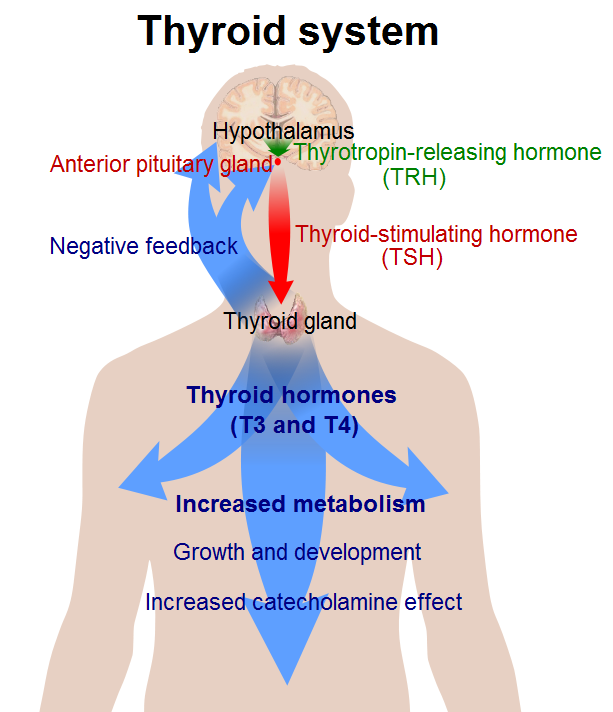
Calcitonin
The calcitonin produced by the parafollicular cells of the thyroid gland has the role of helping to regulate blood calcium levels by stimulating the movement of calcium into bone. Calcitonin is secreted in response to rising blood calcium levels. It decreases blood calcium levels by enhancing calcium absorption and deposition in bone. Calcitonin works hand-in-hand with parathyroid hormone, which is secreted by the parathyroid glands and has the opposite effects as calcitonin. Together, these two hormones maintain calcium homeostasis.
Thyroid Disorders
As with other endocrine disorders, thyroid disorders are generally associated with either over- or under-secretion of hormones. Abnormal secretion of thyroid hormones may occur for a variety of reasons.
Hyperthyroidism
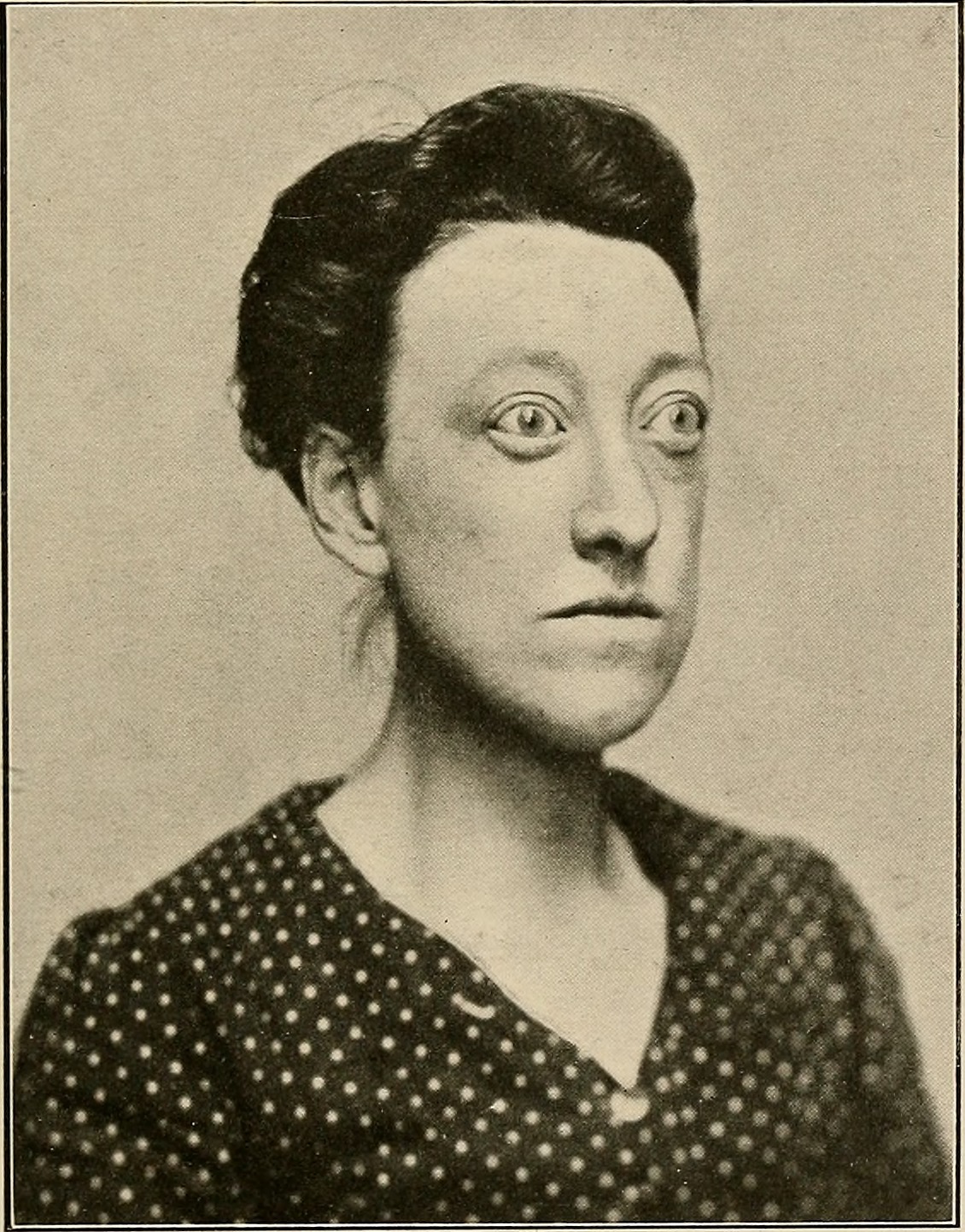
Hyperthyroidism occurs when the thyroid gland produces excessive amounts of thyroid hormones. The most common cause of hyperthyroidism is Graves’ disease. Graves’ disease is an autoimmune disorder in which abnormal antibodies produced by the immune system stimulate the thyroid to secrete excessive quantities of its hormones. This stimulation overrides the usual negative feedback mechanism that normally controls thyroid hormone output. Graves’ disease often results in the formation of an enlarged thyroid (goiter) because of the continued stimulation to produce more hormones.
Besides a goiter, other signs and symptoms of hyperthyroidism may include protruding eyes (see Figure 9.5.5), heart palpitations, excessive sweating, diarrhea, weight loss despite increased appetite, muscle weakness, and unusual sensitivity to heat. Medications can be prescribed to mitigate the symptoms of the disease. Anti-thyroid drugs can also be given to decrease the production of thyroid hormones. If the drugs are ineffective, the gland can be partially or entirely removed. This can be done surgically or with the administration of radioactive iodine. Removal of the thyroid produces hypothyroidism.
Hypothyroidism
Hypothyroidism occurs when the thyroid gland produces insufficient amounts of thyroid hormones. It can result from surgical removal of the thyroid. However, worldwide, the most common cause of hypothyroidism is dietary iodine deficiency. In cases of iodine deficiency, the negative feedback loop controlling the release of thyroid hormone causes repeated stimulation of the thyroid, resulting in the thyroid gland growing in size and producing a goiter. Although the gland gets larger, it cannot increase hormone output because of the lack of iodine in the diet.
Iodine deficiency is uncommon in the Western world because iodine is added to salt. In places like this where iodine deficiency isn’t a problem, the most common cause of hypothyroidism is Hashimoto’s thyroiditis. This is another autoimmune disease, but in this case, the immune system destroys the thyroid gland, producing hypothyroidism. Hashimoto’s thyroiditis tends to run in families, so it is likely to have a genetic component. It usually appears after the age of 30, and is more common in females than males.
Hypothyroidism produces many signs and symptoms, as shown in Figure 9.5.6. These may include abnormal weight gain, tiredness, baldness, cold intolerance, and slow heart rate. Hypothyroidism is generally treated with thyroid hormone replacement therapy. This may be needed for the rest of a person’s life.

Hypothyroidism in a pregnant woman can have serious adverse consequences for the fetus. During the fetal period, cells of the developing brain are a major target for thyroid hormones, which play a crucial role in brain maturation. When levels of thyroid hormones are too low, the fetus may suffer permanent deficits in cognitive abilities. Deafness is also a potential outcome of hypothyroidism in utero.
Feature: Myth vs. Reality
Thyroid disorders are relatively common, affecting as many as 20 million people in the United States. According to recent studies, one in ten Canadians have some type of thyroid condition and up to 50 per cent may be undiagnosed! Because thyroid disorders are common, there are also many common myths about them.
Myth |
Reality |
| “If you have a thyroid problem, you will know something is wrong because you will have obvious symptoms.” | The majority of people with a thyroid disorder are not aware they have it, because the symptoms are often mild, nonspecific, and easy to ignore. Generally, blood tests of thyroid hormone levels are needed to make a conclusive diagnosis. |
| “If you are diagnosed with a thyroid disorder, you will have to take medication for the rest of your life.” | Whether you need to continue thyroid medication for life depends on the cause of the disorder. For example, some women develop hypothyroidism during pregnancy but no longer need medication after the pregnancy is over and hormone levels return to normal. |
| “As soon as you start taking thyroid medication, your symptoms will resolve.” | It often takes weeks — or even months — for thyroid hormone levels to return to normal and for symptoms to disappear. |
| “You can take an over-the-counter iodine supplement to correct hypothyroidism.” | In the United States, where dietary iodine is almost always adequate, iodine deficiency is unlikely to be the cause of hypothyroidism. Therefore, taking supplemental iodine is not likely to correct the problem. |
| “If thyroid symptoms are mild, you don’t need to take medication.” | Because thyroid hormones are responsible for so many vital body functions, failing to treat even a mild thyroid disorder may lead to a range of other problems, such as osteoporosis or infertility. |
| “Goiter may be caused by eating “goitrogenic” vegetables, such as broccoli, Brussels sprouts, and spinach.” | Although these foods can interfere with the thyroid’s ability to process iodide, you would have to eat huge amounts of them to cause a goiter. |
| “Thyroid disorders occur only after middle age and only in women.” | Thyroid disorders may occur at any age and in any sex. Hypothyroidism occurs more commonly in older adults, but hyperthyroidism occurs more commonly in younger adults. Although women are more likely to develop thyroid disorders, about 20 per cent of cases occur in men. |
9.5 Summary
- The thyroid gland is a large endocrine gland in the front of the neck. It is composed mainly of clusters of cells called follicles, which are specialized to absorb iodine and use it to make thyroid hormones. Parafollicular cells among the follicles synthesize the hormone calcitonin.
- Thyroxine (T4) and triiodothyronine (T3) cross cell membranes and regulate gene expression to control the rate of metabolism in cells body-wide, among other functions. The production of T4 and T3 is regulated by thyroid stimulating hormone (TSH) from the pituitary, which is regulated, in turn, by thyrotropin releasing hormone (TRH) from the hypothalamus.
- Calcitonin helps regulate blood calcium levels by stimulating the movement of calcium into bone. It works in conjunction with parathyroid hormone to maintain calcium homeostasis.
- Abnormal secretion of thyroid hormones may occur for a variety of reasons, and it may lead to the development of a goiter. The most common cause of hyperthyroidism is Graves’ disease, an autoimmune disorder. Iodine deficiency is a common cause of hypothyroidism worldwide. In the United States, the most common cause of hypothyroidism is Hashimoto’s thyroiditis, another autoimmune disorder. Hypothyroidism in pregnant women may cause permanent cognitive deficits in children.
9.5 Review Questions
- Describe the structure and location of the thyroid gland.
- Identify the types of cells within the thyroid gland that produce hormones.
-
- Compare and contrast T4 and T3.
- How do T4 and T3 affect body cells?
- Explain how T4 and T3 production is regulated.
- What is calcitonin’s function?
- Identify the chief cause and effects of hyperthyroidism.
- What are two possible causes of hypothyroidism?
- List signs and symptoms of hypothyroidism.
- Why is it that both hyperthyroidism and hypothyroidism cause goiters?
- Choose one symptom each for hyperthyroidism and hypothyroidism. Based on the functions of thyroid hormones, explain why each symptom occurs.
- In cases of hypothyroidism caused by Hashimoto’s thyroiditis or removal of the thyroid gland to treat hyperthyroidism, patients are often given medication to replace the missing thyroid hormone. Explain why the level of replacement thyroid hormone must be carefully monitored and adjusted if needed.
9.5 Explore More
How does the thyroid manage your metabolism? – Emma Bryce, TED-Ed, 2015.
Graves’ Disease and Hashimoto’s Thyroiditis, hardgrindcoffeeyo, 2014.
The Fukushima Nuclear Accident documentary, World Disasters, 2014.
Attribution
Figure 9.5.1
- Goiter by Drahreg01 on Wikimedia Commons is used under a CC BY-SA 3.0 (https://creativecommons.org/licenses/by-sa/3.0) license.
- [adapted] A_woman_suffering_from_Goiter by MyUpchar.com on Wikimedia Commons is used under a CC BY-SA 4.0 (https://creativecommons.org/licenses/by-sa/4.0) license.
Figure 9.5.2
Thyroid gland by National Cancer Institute is in the public domain (https://en.wikipedia.org/wiki/Public_domain).
Figure 9.5.3
Structural model representing a single molecule of thyroxine (T4) from CK-12 Foundation is an image of a chemical structure model and is non-copyrightable.
Figure 9.5.4
Thyroid_system by Mikael Häggström on Wikimedia Commons is in the public domain (https://en.wikipedia.org/wiki/Public_domain).
Figure 9.5.5
Case of Graves disease without goitre by Internet Archive Book Images on Flickr is believed to have No known copyright restrictions. [Image from page 226 of “The thyroid gland in health and disease” (1917)]
Figure 9.5.6
Signs_and_symptoms_of_hypothyroidism by Mikael Häggström. on Wikimedia Commons is used under a CC0 1.0 Universal Public Domain Dedication license (https://creativecommons.org/publicdomain/zero/1.0/deed.en).
About thyroid disease. (n.d.). Thyroid Foundation of Canada. https://thyroid.ca/thyroid-disease/
Häggström, M. (2014). Medical gallery of Mikael Häggström 2014. WikiJournal of Medicine 1 (2). DOI:10.15347/wjm/2014.008. ISSN 2002-4436.
hardgrindcoffeeyo. (2014, July 19). Graves’ disease and Hashimoto’s thyroiditis. YouTube. https://www.youtube.com/watch?v=oINxr8_nR_Y&feature=youtu.be
TED-Ed. (2015, March 2). How does the thyroid manage your metabolism? – Emma Bryce. YouTube. https://www.youtube.com/watch?v=iNrUpBwU3q0&feature=youtu.be
World Disasters. (2014, April 5). The Fukushima nuclear accident documentary. YouTube. https://www.youtube.com/watch?v=-5W7eEX-u3U&feature=youtu.be
An abnormal enlargement of the thyroid gland.
A large endocrine gland in the neck whose hormones control the rate of cellular metabolism and help maintain calcium homeostasis.
An anatomical structure that consists of a small cluster of cells, surrounding a central cavity.
A hormone is a signaling molecule produced by glands in multicellular organisms that target distant organs to regulate physiology and behavior.
An essential mineral commonly found in seafood. Your thyroid gland uses it to make thyroid hormones, which help control growth, repair damaged cells and support a healthy metabolism.
A glycoprotein produced by the follicular cells of the thyroid and used entirely within the thyroid gland.
Neuroendocrine cells in the thyroid. The primary function of these cells is to secrete calcitonin. They are located adjacent to the thyroid follicles and reside in the connective tissue.
A hormone that is produced in humans by the parafollicular cells (commonly known as C-cells) of the thyroid gland. Calcitonin is involved in helping to regulate levels of calcium and phosphate in the blood, opposing the action of parathyroid hormone.
An endocrine hormone secreted by the thyroid gland that increases the rate of metabolism in cells throughout the body.
An endocrine hormone secreted by the thyroid gland that increases the rate of metabolism in cells throughout the body.
An endocrine hormone secreted by the thyroid gland that increases the rate of metabolism in cells throughout the body.
An endocrine hormone secreted by the thyroid gland that increases the rate of metabolism in cells throughout the body.
A hormone secreted by the parathyroid gland which helps regulate blood calcium.
The ability of an organism to maintain constant internal conditions despite external changes.
A disorder in which the thyroid gland produces excessive amounts of hormones.
An autoimmune disorder in which abnormal antibodies produced by the immune system stimulate the thyroid gland to secrete excessive quantities of its hormones.
A control mechanism that serves to reduce an excessive response and keep a variable within its normal range.
A disorder in which the thyroid gland produces inadequate amounts of hormones.
Any gland of the endocrine system, which is the system of glands that releases hormones directly into the blood.
The semipermeable membrane surrounding the cytoplasm of a cell.
The process by which information from a gene is used in the synthesis of a functional protein.
The chemical processes that occur in a living organism to sustain life.
A pituitary hormone that stimulates the thyroid gland to produce thyroxine, and then triiodothyronine which stimulates the metabolism of almost every tissue in the body.
The master gland of the endocrine system that secretes many hormones, the majority of which regulate other endocrine glands.
A part of the brain that secretes hormones and connects the brain with the endocrine system.


